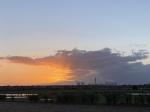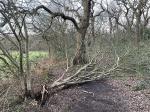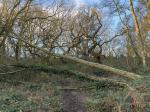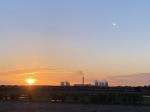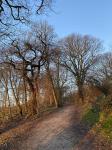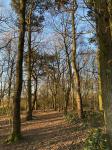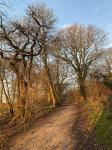Brayton Barff Through the Seasons.
Set in the Vale of York, South West of the market town of Selby and between the villages of Thorpe Willoughby and Brayton, lies Brayton Barff, a sandstone Hill approximately one hundred and fifty feet in height which was formed by glacial movement during the last Ice Age. It is a significant landmark in an otherwise flat landscape.
Today the site is primarily owned by Yorkshire Water with Selby District Council owning a small patch of the land adjacent to the A63 Selby bypass. A large underground reservoir occupies the centre of the site which delivers water to around 4.7 million customers throughout Yorkshire.
Within the Barff woodland over 40% of the trees are Sessile Oak which are generally found in semi natural woodlands in the north of the country. These trees are so called because its acorns are not held on stalks, like those of the English Oak (Pedunculate), but attached directly to the outer twigs. There are also several English Oak trees as well as some cross-hybrid oaks. These trees are known to support many species of flora and fauna, invertebrates, mosses, lichen and fungi.
During the Victorian times it is thought that the shipbuilders on the east coast would come over to the Barff for selected cuts of timber to build their sea going vessels.
The Barff also has a variety of other trees including Silver Birch, Beech, Sycamore, Holly, Rowan, Scots Pine, Alder, Hawthorne and European Larch. There are also several Yew, Willow, Hazel, Horse Chestnut and Wych Elm. As with similar woodlands there are a variety of bushes, including Honeysuckle, Elderberry, Gorse, Broom and Buddleia.
The history of Brayton Barff is quite vague, apparently during 1803 a beacon was lit on the Barff when the country was threatened with an invasion by Napoleon. In May 1935, to celebrate King George V's Silver Jubilee, a Bonfire was lit on the Barff as part of the celebrations.
Early issues of Ordnance Survey Maps dated 1903 clearly show a rifle range on the Barff, extending out to Mill Lane. During the 
Between 2001 – 2004 the A63 Selby bypass, 10km twin lane single carriageway was constructed which severed the South West corner of the Barff, adjacent to Selby Golf Course and resulted in a slight redesign of several holes on the golf course. Wooden fencing was erected as a result of this new road running alongside of the Barff and a footbridge constructed over the ‘new road’ following the line of the Bridal way which extends from Mill Lane. Around 2005/2006 a definite 2metre wide limestone aggregate footpath was laid forming a circular path around the outer edges of the woodland. This footpath is approximately 1.2 miles in length and takes about 30 minutes to circumnavigate at a leisurely pace.
In 2012 the Barff was declared an Ancient Oak Woodland and as such throughout 2012 and 2013 significant work had been carried out by the relevant agencies to cut and remove large swathes of non-native trees, creating at that time huge scars on the landscape. Some three years later the planting of the native trees have become well established and are flourishing. Ongoing maintenance work on the footpath around the bottom of the Barff was completed during the Summer of 2016.
A second phase of woodland maintenance commenced during the Autumn of 2019 with the removal of many old and diseased trees and the cutting back of the Gorse and Broom bushes, especially adjacent to the ‘bypass trail’, this work continued through till March 2020 with re planting continuing into April 2020.
Brayton Barff is a popular site for walkers and bird watchers alike and a path circling the outer perimeter of the Barff makes a pleasant thirty minute walk, giving views looking over towards Selby and the village of Brayton as well as the power stations of Drax and Eggborough..jpg)
For the early risers it is a great place to see some stunning sunrises over the villages of Brayton looking towards Drax Power Station, the same with the Sunsets looking over towards Eggborough and Monk Fryston.
The Barff changes with the Seasons and every visit can reveal something new, the woodland is a haven for wildlife. Records show that since 1982 one hundred and twelve species of bird have been seen in the woodland and at least 40 of those have bred here, including Tawny Owl, Buzzard, Green Woodpecker, Spotted Flycatcher, Goldcrest and Nuthatch to name just a few. On average over 70 species of bird are recorded each year. Further details of the bird life on the Barff can be found on the Brayton Barff Group Facebook page, especially the posts from Derek Cooper. Today ‘The Friends of Brayton Barff group’ led by Derek and a small team of volunteers help keep and maintain the cleanliness of the site as well as recording the wildlife and bird sightings.
The Barff is also home to fifteen different species of mammals, including Muntjac Deer, Pipistrelle Bat, Fox, and Field Vole.
Over eighty species of plant and wildflowers have been recorded, included Bee Orchid, Northern Marsh Orchid, Wood Anemone, Marsh Ragwort, Bluebell, White Bluebell, Bittersweet and Purple and White Foxgloves. Over twenty species of Butterfly have been recorded, including Marbled White, Brown Angus, Speckled Wood, Comma and Brimstone.
During the Autumnal months fungi thrives in this woodland environment, species including Fly Agaric, Beefsteak Tree Fungi, Chicken of the Wood, Sulphur Tufts, Stinkhorn, Ink cap, Puffballs and Hoof Bracket are just some of the many varieties that can be found here.
Click on the galleries shown below to expand the albums.
February 2022
I hate dark early morning dog walks, but as it is to be expected this time of year, there is nothing I can do about it other than wait for Spring to arrive. One of the added benefits of getting onto the Barff earlier than most though, is that I have been privy to some lovely sunrises.
The weather at the beginning of the month was quite settled and mild, but it soon became much more unsettled, with a succession of depressions bringing rain across much of the country, and a particularly stormy spell between the 16th and the 21st which included three named storms. It remained mostly mild, however, especially in southern areas, with few frosts.
We certainly had our fair share of rain this month, I had to resort to wearing my wellies again as the Barff paths and particularly tracks became heavily waterlogged and muddy. According to the statistics February was the 8th wettest February since records began in 1836! That said, Seathwaite, a small hamlet in the lake District had 86mm rain fall on the 20th of the month, so we shouldn’t complain really. The main talking point this month has been the three named storms that hit the country between the 16th to 21st. I was down in Sevenoaks, Kent, for a week when the first storm arrived on the 16th, ScotRail closed just about all its rail network due to fallen trees, many ferry companies cancelled sailings, and many roads were closed due to fallen trees and roofs being blown off buildings. Many areas of the country lost their electricity supplies. ‘Storm Dudley’ was just the start. ‘Storm Eunice’ arrived on the 18th causing considerable disruption across the country, no power, blocked roads, schools being closed were just a few of the aftereffects of the storm. The last of the storms was ‘Storm Franklin’ which arrived on the 20th, and it was this storm which caused most significant damage to our county. As well as power cuts, fallen trees and damage to buildings, the inhabitants of Tadcaster had to endure flooding, again.
The Barff sustained a fair amount of damage throughout the storms with at least six significant trees being blown over, some having their roots uplifted, others losing branches.
The milder weather, bearing in mind we have not had any snow yet, has seen a growth spurt in the wild plants on the Barff, Foxgloves have been visible over the winter period, the green shoots of the Bluebells are poking through in most areas now, as are the nettles and brambles, elderberry bushes are in full bud and will be coming into leaf in a week or so, even several species of fungi can be seen including the colourful ‘Scarlet Elf Cup’, ‘Yellow Brain Fungi’, Birch Polypore’ and ‘Black Jelly Fungus’.
With the milder weather, our birds seem to be coming to life sooner than is usual at this time of year. Nuthatches are certainly becoming more vocal, as are the common Thrush and Mistle Thrushes. Greater Spotted Woodpeckers are busily drumming away most days, preparing for Spring.
Buzzard and Sparrowhawk can be seen around the woodland at anytime of the day, Long Tailed Tits, Tree Creepers, Goldcrest and Dunnocks can be seen on most visits to the Barff as can Robins, Great and Blue Tits, Chaffinch, and Wrens.
|





